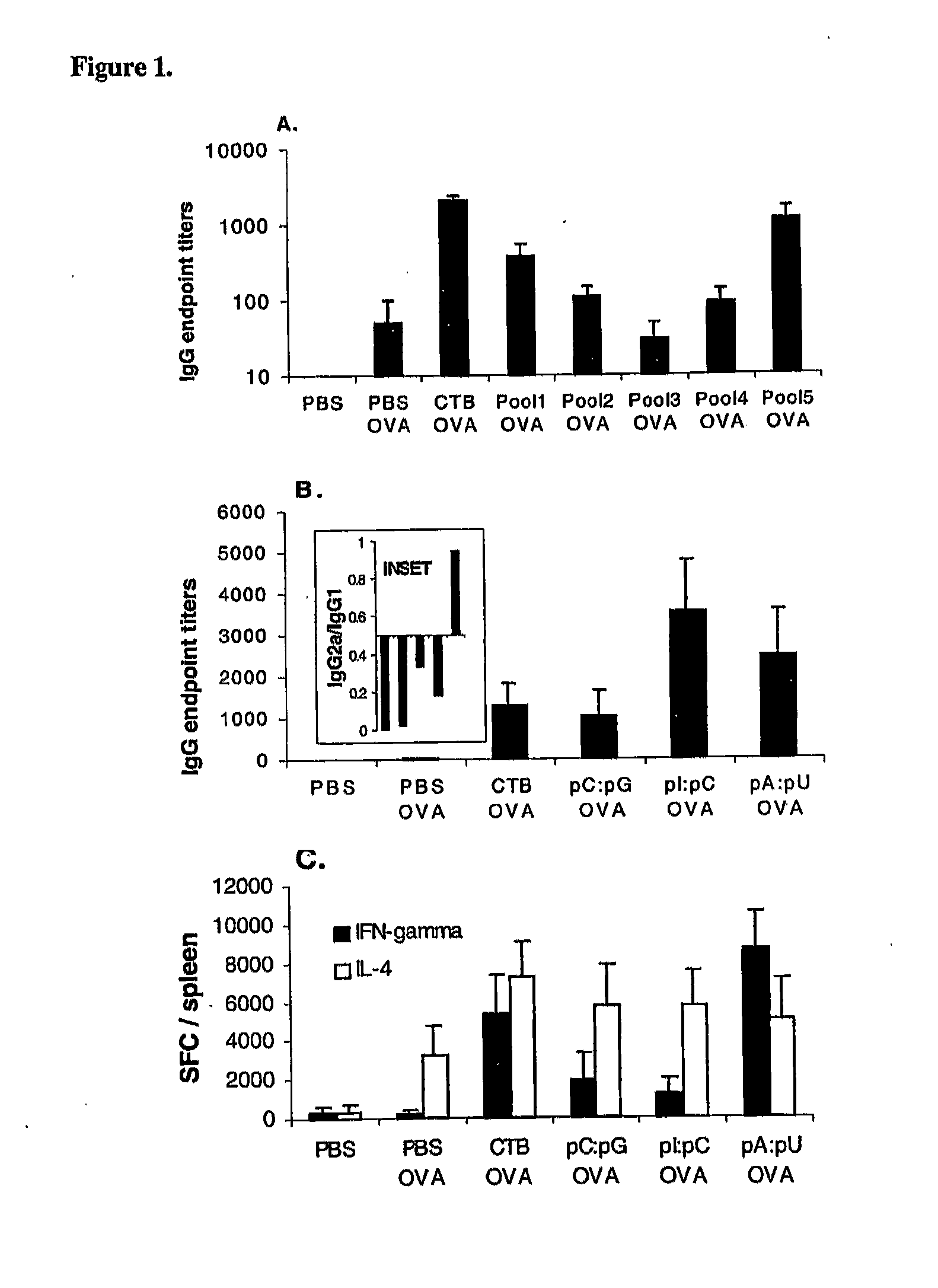Compositions and methods to treat and control tumors
a tumor and tumor technology, applied in the field of motifs, can solve the problems of not being able to demonstrate whether, species only have a limited effect, and the critical question of whether there is a multiplicity of rna-associated danger motifs with potential differential effects on immune responses, and achieves the effect of differential impact on adaptive immunity
- Summary
- Abstract
- Description
- Claims
- Application Information
AI Technical Summary
Benefits of technology
Problems solved by technology
Method used
Image
Examples
example 15
Local (Lung) and Systemic (Splenic) T Cell Response in C57BL / 6 Mice to Whole OVA Antigen or Class I-restricted Dominant OVA Peptide, Subsequent to Immunization with OVA Co-formulated with dsRNA Motifs
[0100]FIG. 5B illustrates the results of local (lung) and systemic (splenic) T cell response in C57BL / 6 mice to whole OVA antigen or class I-restricted dominant OVA peptide measured in mice immunized with OVA in short chain lipid complexes (dioctanoylphosphatidylcholine) with or without pA:pU. The analysis was carried out by ELISPOT and the results expressed as IFN-γ SFC / organ (mean±SEM; n=4 / group).
[0101]Interestingly, CTB had only a limited adjuvant effect in context of short chain lipid complex co-formulation. Consistent with previous results, induction of T1 immunity was measured only with pA:pU particles as shown in FIG. 5B but not pI:pC, which displayed only enhancement of T2 immunity (not shown). Further, the T cell response to pA:pU co-formulated antigen see (“Materials and Metho...
example 17
Non-Replicating dsRNA Motifs Act as Master Switch for the Adaptive (B and T Cell) Immune Response
[0105]Antigens devoid of danger motifs such as dsRNA are poorly immunogenic or if provided in large doses may induce immunological tolerance. However, dsRNA motifs modify the way the immune system perceives the antigen: instead of poor responsiveness or tolerance, such motifs instruct the adaptive (T and B cell) immunity to mount strong responses to co-existing antigens, as well as prevent or block the immunological tolerance. Thus, innate immunity by virtue of recognition of dsRNA motifs operates as master switch for adaptive B and T cell immunity (FIG. 7).
example 18
Naturally Occurring dsRNA Bridges the Innate with Adaptive Immune Response
[0106]Example 18 shows that natural, non-infectious double stranded RNA produced during infection with influenza virus, has substantial effects on the specific immune response to a protein antigen. Permissive MDCK cells were infected with WSN influenza virus (108 TCID50 / 1×109 cells) and after 24 hours, the cells were harvested, washed and the total RNA extracted using an RNA separation kit (Qiagen, Valencia, Calif.). The RNA was further purified by treatment with RNAse-free DNAseI (Stratagene, San Diego, Calif.). The single stranded RNA in the samples was then removed by 30 minutes incubation at 37° C. with 5μ, of S1 nuclease (Ambion, Inc., Austin, Tex.) / μg of RNA. The RNA was analyzed prior to and subsequent to the digestion by gel electrophoresis. The absence of infectious properties of the purified dsRNA was confirmed by standard influenza virus titration. As a control, material purified and treated similar...
PUM
| Property | Measurement | Unit |
|---|---|---|
| molecular weight | aaaaa | aaaaa |
| molecular weight | aaaaa | aaaaa |
| molecular weight | aaaaa | aaaaa |
Abstract
Description
Claims
Application Information
 Login to View More
Login to View More - R&D
- Intellectual Property
- Life Sciences
- Materials
- Tech Scout
- Unparalleled Data Quality
- Higher Quality Content
- 60% Fewer Hallucinations
Browse by: Latest US Patents, China's latest patents, Technical Efficacy Thesaurus, Application Domain, Technology Topic, Popular Technical Reports.
© 2025 PatSnap. All rights reserved.Legal|Privacy policy|Modern Slavery Act Transparency Statement|Sitemap|About US| Contact US: help@patsnap.com



